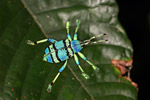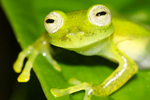
Left: Fiji crested iguana. Photo by: Matthias Liffers. Right: Golden poison frog. Photo by: ProAves.
The seven wonders of the world is an ancient tradition going back to the 2nd Century BCE. But where those first lists focused on manmade marvels, many ‘seven wonders’ today also take note of the natural world. Now, a new program by the Alliance for Zero Extinction (AZE) hopes to use the ‘seven wonders’ concept to highlight imperiled species by allowing people to vote for their favorites.
“The world rallies to preserve the heritage of priceless historical places like the Great Pyramid of Giza or the Colosseum, and we should also protect the places on Earth that harbor the most endangered species,” explains Mike Parr, AZE Chair as well as Vice President of the American Bird Conservancy (ABC). “By highlighting seven places out of the 587 sites that are most important to the preservation of the Earth’s biodiversity, in the tradition of the ‘Seven Wonders of the World,’ we can help draw attention to the importance of saving these sites.”
The AZE works to save species on the edge that are surviving in a single location. To date the organization has identified 587 such sites worldwide. These ecosystems contain at least one species, listed as Endangered or Critically Endangered by the IUCN Red List, that is found no-where else. A recent study found that 51 percent of these site remain unprotected.
For it’s ‘seven wonders list’ the ground has whittled the 587 sites down to 20 site (and corresponding species) for votes to choose from.
“These species have lived on Earth longer than any man-made structure, and we cannot allow them to disappear in the shadows, unnoticed,” said Parr. “We hope citizens feel a sense of pride and vote for the charismatic species found only at the unique places in their country.”
Candidates for AZE’s Seven Wonders
1. Gough Island, UK – Tristan Albatross
2. Isla Robinson Crusoe, Chile – Juan Fernandez Firecrown
3. Abra Patricia, Peru – Long-whiskered Owlet
4. Raso da Catarina, Brazil – Lear’s Macaw
5. Hellshire Hills, Jamaica – Jamaican Ground Iguana
6. Anhui Chinese Alligator Nature Reserve, China – Chinese Alligator
7. Roti Island, Indonesia – Roti Island Snake-necked Turtle
8. Baly Bay National Park, Madagascar – Angonoka Tortoise
9. Yadua Taba Island, Fiji – Fiji Crested Iguana
10. Río Saija, Colombia – Golden Poison Frog
11. Bale Mountains, Ethiopia – Malcom’s Ethiopia Toad
12. Morningside and Handapan Ella Plains, Sri Lanka – Shrub Frog
13. Manas National Park, India – Pygmy Hog
14. Menabe – Andranomena, Madagascar – Madame Berthe’s Mouse Lemur
15. Helan Shan Nature Reserve, China – Helan Shan Pika
16. Rodrigues Mainland, Mauritius – Rodrigues Flying Fox
17. Massif de la Hotte, Haiti – La Hotte Glanded Frog
18. Lower Tana River, Kenya – Tana River Mangabey (monkey)
19. Chatham Islands, New Zealand – Shore Plover
20. Poyang Hu, China – Siberian Cran
Related articles
Teetering on the edge: the world’s 100 most endangered species (photos)

(09/10/2012) From the Baishan fir (five left in the world) to the Sumatran rhino (around 250), a new report highlights the world’s top 100 most endangered species, according to the the International Union for Conservation of Nature (IUCN) and the Zoological Society of London (ZSL). The list spans the taxonomic gamut, from fungi (Cryptomyces maximus) to amphibians (the Table Mountain ghost frog) to flowers (the Cayman Islands ghost orchid) and much more (see full list at the end of the article).
Biodiversity faltering: 20% of invertebrates threatened with extinction

(08/31/2012) Twenty percent of invertebrates are at risk of extinction, according to a new report that looks at the 12,621 invertebrates assessed by the IUCN Red List to date. Although invertebrates never garner the same conservation attention as big, charismatic animals such as tigers and elephants, they play an undeniable role in maintaining healthy ecosystems. In addition, since invertebrates make-up 80 percent of the world’s species, the report raises new concerns about global biodiversity decline.
Private reserve safeguards newly discovered frogs in Ecuadorian cloud forest

(08/28/2012) Although it covers only 430 hectares (1,063 acres) of the little-known Chocó forest in Ecuador, the private reserve las Gralarias in Ecuador is home to an incredible explosion of life. Long known as a birder’s paradise, the Reserva las Gralarias is now making a name for itself as a hotspot for new and endangered amphibians, as well as hundreds of stunning species of butterfly and moth. This is because the reserve is set in the perfect place for evolution to run wild: cloud forest spanning vast elevational shifts. “The pacific slope cloud forests […] are among the most endangered habitats in the world,” explains Reserva las Gralarias’ founder, Jane Lyons, in a recent interview with mongabay.com.